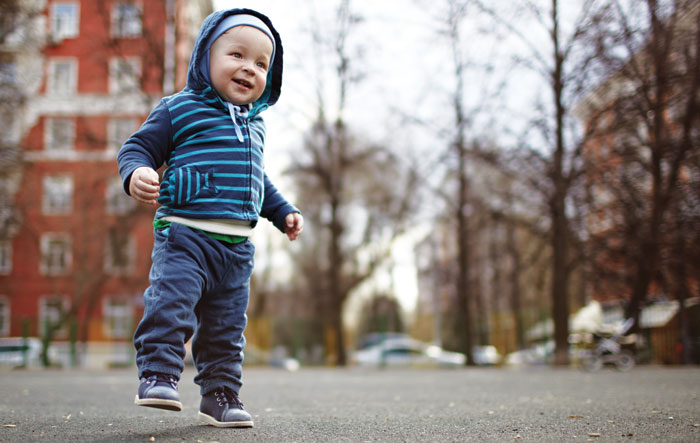Once your child takes those first steps, it’s time to get a real pair of shoes, courtesy of Easy Parenting Magazine

Most children start walking between 10 and 18 months, although this varies from child to child. Even though you may want to protect your baby’s feet when they are beginning to walk, it’s important to avoid structured shoes until your child is ready to walk outdoors. While still learning indoors, bare feet are good for grip, or soft-soled booties or socks will suffice. Once your child is able to walk unaided or walk about most of the day, you may need to invest in a proper, protective-soled pair of shoes.
Paediatricians and podiatrists recommend that children’s early shoes allow for natural movement and development of the feet. Medical studies show that they should be as close as possible to walking barefoot, while still allowing for protection from the external environment (such as cold temperature, hard floors, outside surfaces, etc). To achieve this, shoes should be as soft and flexible as possible and also allow the child’s feet to breathe.
Feet take time to develop
It takes about 18 years for a human’s foot to develop fully. The foot contains 22 partially formed bones at birth. These are spongy and soft and at a few months old the foot can even be pushed out of shape by a tight sock, restrictive sleep suit or sheets! By about four years, the bones will have increased to 45 partially fused bones, but it will take the next 14 years for these bones to fuse together to form the adult foot with 26 bones (28 if you include the sesamoid bones at the base of the big toe).
Buying well-fitted shoes, from a trained shoe fitter is hugely important as ill-fitting shoes can affect the alignment of bones. There is no such thing as an average foot, and feet change as they mature. Feet vary in arches, insteps and toes too, so getting the shoes fitted correctly is a must for your child’s comfort.
The longer a child walks without shoes, the more they are allowed to develop naturally. Experts recommend letting your child go barefoot or sock-covered for as long as possible to allow tiny feet to develop for longer. Of course, when they are eager to get outside and exploring, it’s time to protect their feet with proper shoes. It’s also important to check children’s feet every four to six weeks to ensure their shoes still fit correctly. Children’s feet grow, on average, two full sizes a year until they are four years old.
Tips for buying first shoes
A very flexible sole
Bend the shoe in your hand, checking it for flexibility. Ideally, you should be able to fold the shoe in half. For outside wear, the sole should be thick enough to protect baby’s feet from sharp or rough objects. Children before the ages of four years of age should be in a flexible shoe in order for muscles to develop without restriction of movement. Breathable uppers and lining
Select shoes that are preferably leather or canvas (not synthetic). Have a look at where the leather is cut and feel the leather with your fingers. The synthetic leather is smoother and has a synthetic (usually black) material backing. Using shoes that do not breathe can cause bacterial problems with your child’s feet at an early age.
No high-tops and definitely no heels!
High-top (ankle) shoes or boots can restrict the movement of a baby’s ankles, possibly leading to developmental problems. And heels can drastically effect the development of your child’s feet. Look for plenty of toe room. Toe room is not only important in making sure that baby’s feet have room to grow, but also baby needs to be able to wiggle his/her toes freely. It’s best to have about 1cm of space (or one finger width) in the toe area.
A comfortable interior
Put your fingers inside of the shoe and check for any hard seams or ridges that might irritate your baby’s foot.
No arch support
Arch support should not be built into shoes for children under the age of three (unless directed otherwise by a professional). The arches, bones, and ligaments of the feet are still developing, and the feet need to grow and develop naturally without being artificially supported. As the child progresses from three years of age upwards arch support becomes more important.
Expert Advice
“A baby’s first pair of shoes should fit well around the ankle and instep to support the foot in walking, this should have a little room at the toes. Use big toe or second toe if longer as length guide and leave approx 5mm more in length. The sole of the shoe should be stable and quite stiff on the shank (this is just after the heel area). It should also flex at the front of the shoe. Most babies toe walk (up to three years), but getting the right shoe can help support the foot and ankle in their first steps.”
– Veronica Daniels, Podiatrist

